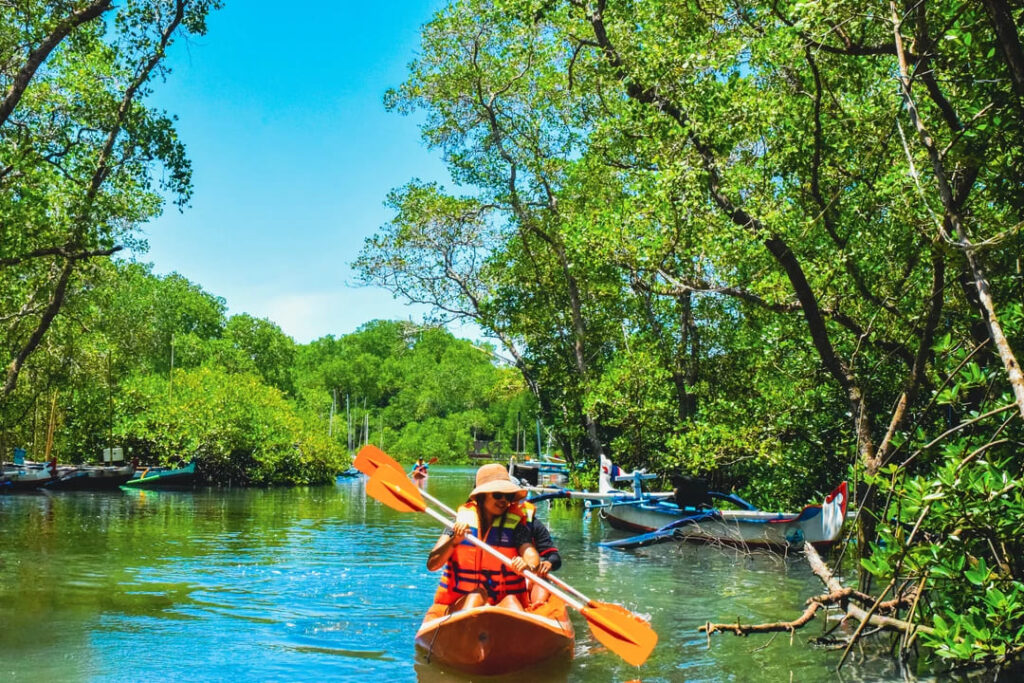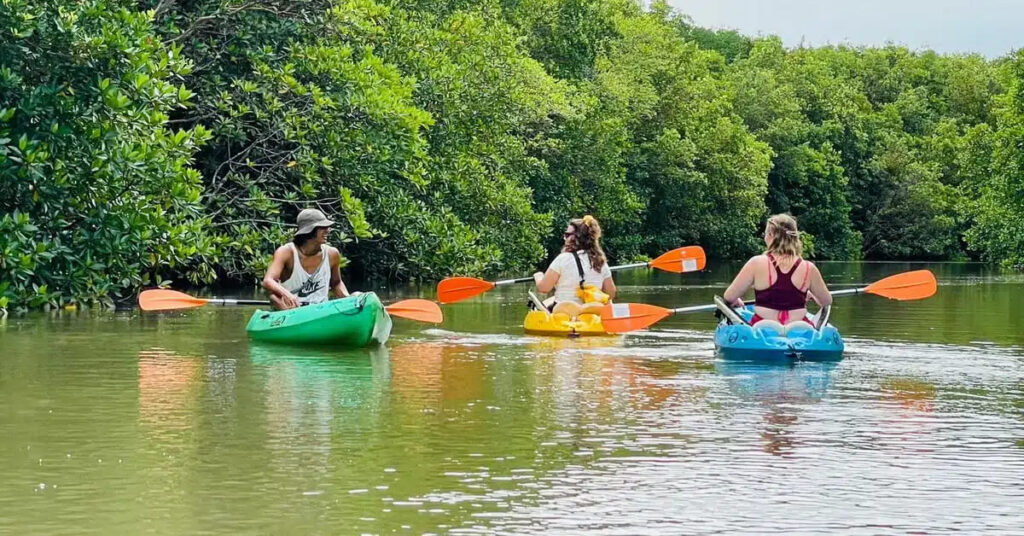Phillip Island, identified in Australia, boasts an extraordinary natural environment and rich biodiversity. The circular island is located at about 140 km southeast of Melbourne and has something for everyone, including the unique coastal wetlands constituted by various mangrove systems as major highlights. One of the best ways to explore the mangroves by canoe is on a canoe which provides a close up view of this important ecosystem. However, going canoeing in the mangroves is not just a recreational activity; it is also an enlightening experience in regard to the interactions that take place within these ecosystems. This article will introduce you to the enchanting world of the mangroves of Phillip Island, and some of the experiences that you will never forget while at the –on a canoe.

Mangrove Vegetation
Definition and Characteristics
A mangrove is defined as a type of wetland along the coast with trees that can tolerate salinity and other forms of interface between land and water. Through these aerial roots, these exceptional trees are able engage in the habitation where brackish waters, or the mixing of salty and fresh waters occur like at the coastal fringes. These varied root structures serve two important functions, the first one is to prevent soil erosion along the coast and secondly providing “safe harbor” for various aquatic organisms. Mangroves can grow to an elevation of more than fifty feet and are indigenous to the temperate regions and tropics of the world.
These trees serve the functions of water treatment, keeping pollutants at bay and also acting as a fish breeding ground. They show a lot of resistance and serve important ecological functions hence the reason for conservation and management.

Importance of Mangroves in Ecosystems
That is, the importance of mangroves does not only lie in their beauty; they perform various functions within coastal ecosystems. First, they serve as defense against coastal erosion and storm surges, thus helping to shield nearby inhabitants from natural disasters. Second, there are those creatures that depend on the mangrove for food which include but are not limited to; numerous varieties of fish, shrimps, birds, and even some mammals. In other words, these ecosystems are also pertinent in the process of carbon inflow since they sequestrate carbon dioxide which has become a greenhouse gas, hence contributing to global warming. The effectiveness of these habitats encompasses not only the animal life but also human beings who rely on the complex economic structures provided by the very productive waters of the mangroves. The sustainability of these ecosystems is a necessity if we are to maintain ecological diversity and build the resilience towards the impacts of climate change.

Phillip Island’s Mangroves
Geography and Biodiversity
The mangroves on Phillip Island are found along its northern shoreline where they are established within the intertidal areas of excluded bays and inlets. The total area of these mangrove forests is fairly around XX acres which makes it important for the breeding and nursery of different marine species.
They do not just stop encroachment on land but also grow a diverse range of flora and fauna, while some of them may be of critical conservation status. Some such vegetation species are those that are referred to as primary mangrove types including the Black Mangrove and Red Mangrove as well as other types of grasses and other small stinging plants. Phillip Island’s mangroves, as wisely referred to, are not short of rich wildlife with either fishes, crabs or the migratory Eastern Curlew and Rainbow Bee-eater that can be encountered. Or take a canoe trip around the mangroves to see what is so fascinating about them and their plant and animal life while standing right in the action.

Conservation Efforts
As a result, much attention has been directed towards ensuring the environmental protection of the mangrove areas in Phillip Island. Efforts to rehabilitate mangrove vegetation and create awareness as to why these are important within the local communities have been collated by local non governmental organizations and the local government. Such activities are complemented by the members of the community who carry out tree planting, education programs and assist the mangrove conservation volunteer days. By conserving the mangroves, and not just cut them down for development purposes, people living on the islands are making sure that their children and grandchildren will also be able experience and benefit from such ecosystems. With a common goal of what is sustainable, the people of Phillip Islands tudi ID services intend to continue caring for the mangroves of the island for the future wellbeing.
Canoeing Through Phillip Island’s Mangrove Swamps
Know More about Canoeing in Mangroves
Canoeing through Phillip Island’s mangroves is an eco tourist activity that helps the visitors to get in touch with the natural surroundings. This not only provides scenic views and interactions with the fauna but also encourages the visitors to travel in a responsible manner. As you silently paddle through the natural waters, you view this complicated biome from a perspective which many others do not get. The peacefulness which is achieved while canoeing among the mangroves takes one away from the stressful life and makes one to admire the beauty of nature. Also canoeing is one of the most enjoyable activities and at the same time helps to be healthy, sensible exercise targeting a bit of leisure activity. Most significantly, it helps to sensitize the community on the conservation of such crucial ecosystems for the current and the future generation.
Canoe Rentals and Guided Tours Available
For those people who also want to canoe through mangroves in Phillip Island several options are available including hence canoe rental and guided canoe tours. There are numerous companies that rent out canoes to the public who are willing to go out by themselves while some can offer family tandem canoes for hire. Guided tours lead by locals who are familiar with the area are also available for those who would like to learn something.
Typically, these tours create awareness about the ecosystem, the wildlife, and the conservation projects taking place in the vicinity of the island. Here are some of the options that will be helpful when planning your adventure:
| Service | Type | Price Range |
|---|---|---|
| Island Canoes | Rental | $30-$60 an hour |
| Wildlife Canoe Tours | Guided | $75 per person |
| Phillip Island Adventure Tours | Guided | $90 per person |
What to Look Out for While Canoeing
Wildlife Spotting
Canoeing through the mangroves provides a very good chance of seeing a wildlife that would might be easily overlooked. Various species that make up the wildlife are present and could be spotted in these ecosystems for instance the beautiful Great Egret, the curious dolphins, and many fish swimming underneath. Other than these, mangroves are even home to a variety of other crustaceans such as the mud crab which increases the concentration of life around. Ethical wildlife watching is important; people should be still and quiet so that wildlife is not scared by their presence. This caution makes it possible for you to have a rare observational experience without adverse effects on the ecosystem. Along the various waterways that you take, paddle smoothly allowing nature to take its course. Paddling referred to the mangroves should be a pleasure and is done at the pleasure of the sights in the environment.
Navigational Tips and Safety
Once you are ready to go to the mangroves, it is a good practice to have some navigational tips and safety tips in mind.
To begin with consult the map showing the waterways and make sure to look out for hazards minimum tree branches or underwater snags. Unless there is a well-defined path that could damage delicate areas and sensitive fauna, it is advisable to use it. Also, make sure that there is always a life jacket on and the canoe has all the safety equipment required. Furthermore, take into account the way color schedules; on the sea shore that will be navigated, low tide may in some areas unveil mud flats which will present a barrier to boating activity. Lastly in this series do not forget to carry enough water and a sunblock; as there is danger of dehydration and to avoid sunburns during the trip. Following these, you will be safe and have a good time when looking through the mangrove mysteries of Phillip Island.
Conclusion
Canoe safaris into the mangroves of Bali , Phillip Island specifically , can create something about the unity of land, water and wildlife which is the goal of most adventurers , within these ecological ecosystems. This eco-tourism activity gives one the physical experience of these ecosystem interfaces and develops the awareness on their conservation. With stunning views surrounding you and huge amounts of wildlife surrounding you , mangrove canoeing is an adventure one cannot forget. Moving around with the gondola in this nature, you will all experience the socially ecologically awareness of reed areas and its conservation.
So grab your paddle and set forth upon a journey and discover the hidden features of nature—an expedition to the quiet mangroves of Phillip Island is in hand.
FAQs
1. What time of the year is most suitable for canoeing in the mangroves of Phillip Island?
Canoeing in Phillip Island’s mangroves is best done in summertime, between the latter part of spring and early autumn, the seasons when weather conditions are more conducive and wildlife activity is likely to be at its peak.
2. Is it possible to get a guide for the canoe tours on Phillip Island?
Absolutely, there are a number of operators who provide canoe tours in the mangroves, conducted by local guides. These enrich the experience through additional information offered concerning the ecology and its elements.
3. What do I need to do so that I can be sure that I am engaging in eco-friendly canoeing in the mangrove areas?
In order to canoe ethically, you need to use designated paths, do not harass animals, do not pollute the landscape, and avoid the tendency to navigate into or close to fragile sites that can harm the mangrove roots.
4. What types of animals can one see in the underwater ecosystems when canoeing through the mangroves?
Many different types of birds, fish, and crabs, and sometimes even wallabies from the shore could be spotted while in the canoes. Different seasons also tallied there were different wildlife viewings.
5. Do I have to bring special skills or equipment to paddle a canoe in Phillips Island’s mangroves.
None other than the basic skills one requires in order to paddle the canoe canoes since this is a very simple activity that a beginner can do. Usually, all gear including life jackets is used by the rental companies and can be used by the clients. It’s helpful to possess some rudimentary skills in paddling, however, going on a tour with a guide helps newcomers.



